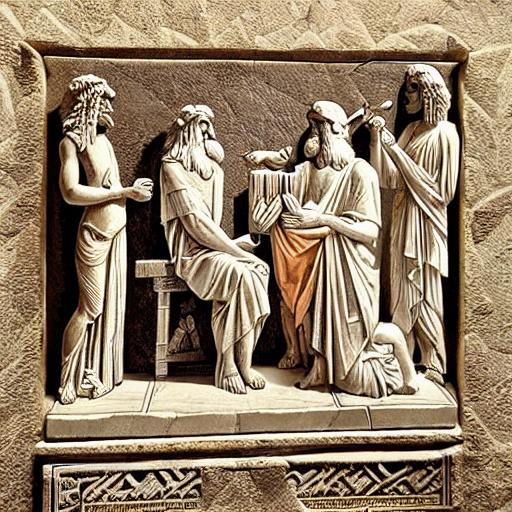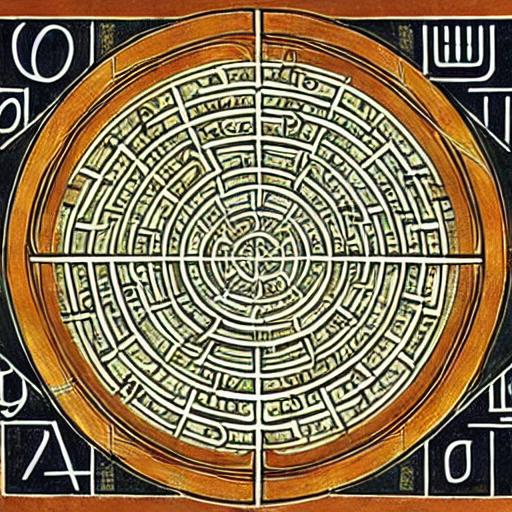When we think of ancient Greek mathematics, Pythagoras is often one of the first names that comes to mind. Famous for his theorem about right triangles, this 6th-century BCE philosopher, mathematician, and mystic founded a school of thought that extended far beyond what we now consider mathematics. The Pythagoreans believed that numbers were the fundamental building blocks of reality, imbued with mystical properties and cosmic significance. This worldview shares remarkable similarities with gematria traditions, suggesting that had Pythagoras encountered Jewish gematria, he would have recognized a kindred numerical philosophy.

Pythagoras and His Number Philosophy
Before exploring the connections to gematria, it's important to understand Pythagoras's unique approach to numbers and their significance.
The Mystical Mathematician
Pythagoras (c. 570 – c. 495 BCE) established a community in Croton, southern Italy, that was part philosophical school, part religious brotherhood. His followers, known as Pythagoreans, lived by strict rules and shared a belief system centered on the mathematical order of the universe.
Unlike modern mathematicians who generally view numbers as abstract tools, Pythagoras and his disciples saw numbers as having inherent qualities, personalities, and even gender. They believed that understanding numbers was the key to understanding the cosmos itself.
Numerical Cosmology
For the Pythagoreans, "all is number" was a fundamental principle. They attributed specific meanings to individual numbers:
- One (Monad): The source of all numbers, representing unity, indivisibility, and the divine source
- Two (Dyad): The first female number, representing duality, opinion, and division
- Three (Triad): The first true male number, representing harmony as it contains beginning, middle, and end
- Four (Tetrad): Representing justice, stability, and the physical world (four elements, four seasons, etc.)
- Five (Pentad): The marriage number (union of first female and first male numbers)
- Six (Hexad): The first perfect number (equals the sum of its divisors: 1+2+3=6)
- Seven (Heptad): The virgin number, associated with wisdom and light
- Ten (Decad): The perfect number, representing the universe (1+2+3+4=10)
This attribution of qualities to numbers parallels the way gematria systems associate numerical values with deeper meanings.
The Tetractys
Central to Pythagorean numerical mysticism was the tetractys, a triangular figure consisting of ten points arranged in four rows: one, two, three, and four points in each row. This figure was so sacred that Pythagoreans would swear oaths by it.
The tetractys represented the organization of space (point, line, surface, solid), the harmony of music (discovered by Pythagoras in the ratios 1:2, 2:3, 3:4), and the cosmic order. It was a visual representation of how the universe emerges from unity (the one) into multiplicity while maintaining harmonic relationships.
Parallels with Gematria
The Pythagorean approach to numbers shares several key elements with gematria traditions:
Numbers as Cosmic Language
Both Pythagoreanism and gematria view numbers as more than mathematical tools—they see them as a fundamental language of reality. In both traditions, numerical relationships reveal hidden connections between seemingly disparate elements of the universe.
Pythagoras discovered that musical harmonies correspond to simple numerical ratios, leading him to propose that the entire cosmos operates according to mathematical harmony—an idea he called "the music of the spheres." Similarly, gematria practitioners believe that the numerical values of words reveal connections and harmonies not evident in ordinary language.
Isopsephy: The Greek Cousin of Gematria
While Pythagoras himself isn't directly connected to alphanumerical systems, ancient Greeks practiced isopsephy—a system remarkably similar to Hebrew gematria. In isopsephy, Greek letters were assigned numerical values:
- Alpha to Theta (α-θ): 1-9
- Iota to Koppa (ι-ϟ): 10-90
- Rho to Sampi (ρ-ϡ): 100-900
This system allowed Greeks to calculate the numerical value of words and names, much like Hebrew gematria. One famous example appears in graffiti from Pompeii: "I love her whose number is 545." This shows that alphanumerical calculations were used in everyday contexts in the ancient Greek world.
The Pythagorean school almost certainly would have been aware of isopsephy, given their intense interest in numerical relationships. The practice aligns perfectly with their belief that numbers underlie all aspects of reality.
Number Symbolism
Both traditions assign symbolic meanings to specific numbers:
- Seven: In Pythagoreanism, seven was the virgin number associated with wisdom. In Hebrew tradition, seven represents divine perfection, creation, and completion.
- Ten: The Pythagorean decad symbolized completeness and the universe. In Kabbalah, ten sefirot represent the emanations of God that created and sustain the universe.
- Four: Pythagoreans connected four to the physical elements and stability. In Jewish tradition, four often represents completeness (four matriarchs, four species on Sukkot, etc.).
These parallel symbolic systems suggest a common intuition about numerical significance across different cultures.
Historical Connections
While we cannot definitively prove direct influence between Pythagoreanism and Jewish mystical number traditions, historical evidence suggests possible connections:
Greek-Jewish Interactions
After Alexander the Great's conquests in the 4th century BCE, Hellenistic culture spread throughout the Mediterranean and Middle East, including Jewish communities. This period saw significant Greek influence on Jewish thought, particularly in Alexandria, Egypt—a major center of Jewish Hellenistic culture.
The translation of the Hebrew Bible into Greek (the Septuagint) during this period demonstrates the cultural exchange taking place. It's plausible that Greek numerical ideas, including Pythagorean concepts, influenced Jewish thinkers during this time.
Neopythagoreanism and Early Kabbalah
By the 1st century CE, Neopythagoreanism—a revival of Pythagorean ideas—was flourishing in the Roman Empire. This coincided with the early development of mystical traditions in Judaism that would later evolve into Kabbalah.
Scholars like Philo of Alexandria (c. 20 BCE - c. 50 CE), a Hellenistic Jewish philosopher, attempted to harmonize Greek philosophy (including Pythagorean elements) with Jewish thought. His work on the symbolic meaning of numbers in the Torah shows clear Pythagorean influence.
The Sefer Yetzirah
The Sefer Yetzirah (Book of Formation), one of the earliest Kabbalistic texts (dating between the 2nd and 6th centuries CE), describes the creation of the universe through the 22 letters of the Hebrew alphabet and the ten sefirot. This framework bears remarkable similarities to Pythagorean cosmology, with its emphasis on numbers and letters as fundamental creative forces.
While direct influence cannot be proven, the conceptual parallels suggest either cultural transmission or independent development of similar ideas about the mathematical structure of reality.
Numerical Mysticism in Practice
How did these philosophical systems apply their numerical principles in practice?
Pythagorean Applications
Pythagoreans applied their numerical philosophy in several practical ways:
- Music theory: By discovering the mathematical ratios underlying musical harmony, Pythagoreans developed a scientific approach to music that influenced Western music theory for millennia.
- Astronomy: They proposed that celestial bodies move according to mathematical principles, creating cosmic harmony.
- Medicine: Pythagorean medical practitioners used numerical correlations to diagnose and treat illness, believing that health represented numerical balance.
- Architecture: Pythagorean principles influenced architectural design, particularly the use of harmonious proportions based on simple ratios.
These applications demonstrate how their numerical philosophy extended into practical domains, much as gematria would later be applied to various aspects of religious and cultural life.
Gematria Applications
Similarly, gematria has been applied in numerous practical contexts:
- Biblical interpretation: Revealing connections between seemingly unrelated passages through shared numerical values
- Legal reasoning: In Talmudic discourse, gematria sometimes serves as supporting evidence for legal interpretations
- Amulets and protective charms: Words or phrases with specific numerical values used for spiritual protection
- Determining auspicious times: Calculating favorable days or years based on numerical correspondences
Both traditions moved from abstract philosophical principles to concrete applications in daily life.
Why Pythagoras Would Have Embraced Gematria
Had Pythagoras encountered the Jewish gematria tradition, several aspects would likely have resonated deeply with his mathematical mysticism:
Revealing Hidden Order
Pythagoras sought to uncover the hidden mathematical order underlying the apparent chaos of existence. Gematria serves precisely this function by revealing numerical patterns beneath the surface of language. The discovery that seemingly unrelated words share the same numerical value would have appealed to his sense that numbers reveal the underlying unity of diverse phenomena.
The Sacred Alphabet
The Pythagorean understanding of number as the foundation of reality parallels the Kabbalistic view of Hebrew letters as the building blocks of creation. Both traditions see their respective alphabets/number systems as more than human conventions—they view them as reflections of cosmic structure.
The Hebrew conception of God creating the world through letters and words would have resonated with Pythagorean ideas about the divine origins of number. Both systems suggest that by studying these fundamental elements (numbers or letters), humans can gain insight into divine wisdom.
Mathematical Harmony
Pythagoras's discovery of mathematical ratios in musical harmony demonstrated how numerical relationships create aesthetic beauty. Gematria similarly reveals harmonious numerical relationships within sacred texts, suggesting a divine "composer" behind the scriptural "music."
The idea that the Torah might be structured according to precise numerical patterns would have aligned perfectly with Pythagoras's belief that divine wisdom expresses itself through mathematical harmony.
Modern Significance of These Connections
The parallels between Pythagoreanism and gematria remain relevant today in several contexts:
Cross-Cultural Mathematical Mysticism
The similarities between these traditions highlight a cross-cultural human tendency to ascribe deeper meaning to mathematical patterns. From Pythagoras to Kabbalah, from Islamic abjad numerals to Chinese numerology, diverse cultures have independently developed systems that view numbers as carriers of meaning beyond calculation.
This suggests something fundamental about human cognition—our brains seem naturally inclined to seek and find meaningful patterns, particularly in abstract systems like numbers.
Contemporary Mathematical Philosophy
Modern debates about whether mathematics is discovered or invented echo ancient questions raised by both Pythagoreans and gematria practitioners. The Pythagorean position that numbers have an objective existence independent of human minds has modern proponents among mathematical Platonists.
Contemporary physicists and mathematicians sometimes express wonder at the "unreasonable effectiveness of mathematics" in describing physical reality—a sentiment that would have been completely familiar to both Pythagoras and Kabbalistic gematria practitioners.
Digital Age Connections
In our digital age, we've returned to a world where everything is ultimately encoded in numbers. Our digital text, images, and experiences are all, at the foundational level, sequences of binary digits. This digital reduction of diverse phenomena to numerical code bears a striking resemblance to the ancient practices of gematria and Pythagorean numerology.

The modern field of information theory, which explores how information can be quantified, stored, and communicated, has conceptual roots that would be recognizable to both Pythagoreans and gematria practitioners.
Conclusion: Ancient Wisdom for Modern Times
The philosophical kinship between Pythagoreanism and gematria reveals how ancient mathematical mysticism anticipated important aspects of our modern understanding of reality. Both traditions recognized that beneath the surface appearance of things lies a deeper mathematical structure that unifies diverse phenomena.
Were Pythagoras to encounter gematria today, he would likely recognize it as a sophisticated system aligned with his own vision of a numerically structured cosmos. The practice of finding meaning in the numerical values of words would seem a natural extension of his belief that "all is number."
As we continue to explore the mathematical foundations of physical reality through modern science, and as we encode ever more of our human experience into digital numeric form, perhaps we're not so far from the worldviews of either Pythagoras or the gematria mystics. Their ancient wisdom—that numbers are not merely tools for calculation but windows into the deeper structure of reality—may have more relevance in our digital, mathematically-modeled world than we might initially suppose.
